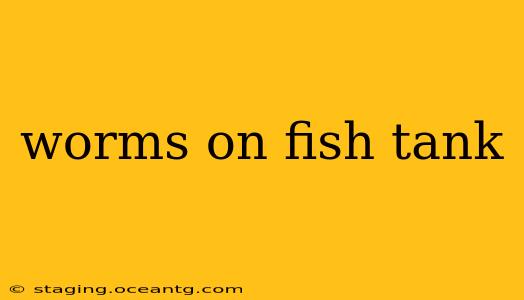Worms in your fish tank can be a distressing sight for any aquarium enthusiast. While some worms are harmless and even beneficial, others can indicate a serious problem within your aquarium ecosystem. This comprehensive guide will help you identify the culprits, understand the underlying causes, and implement effective solutions to eradicate these unwanted guests.
What Kinds of Worms Are Commonly Found in Fish Tanks?
This is a crucial first step. Not all worms are created equal. Some are beneficial, others are parasitic, and some are simply opportunistic feeders thriving in less-than-ideal conditions. Knowing which type you're dealing with will dictate your course of action. Common culprits include:
-
Planaria: These flatworms are usually small and light-colored. While some types are harmless scavengers, others can prey on fish eggs and even smaller fish. Their presence often points towards overfeeding or decaying organic matter in the tank.
-
Rhabdocoela: Similar in appearance to planaria, rhabdocoela are generally harmless detritivores (meaning they feed on decaying matter). Their presence isn't usually cause for alarm unless their population explodes.
-
Nematodes: These thread-like worms are often microscopic and difficult to spot without magnification. They can be beneficial, breaking down organic waste, or parasitic, feeding on fish.
-
Tubifex worms: These red, segmented worms are commonly sold as fish food. However, they can also proliferate in tanks with poor water quality, indicating a problem with waste buildup.
-
Leech infestation: While less common, leeches can be a serious issue. They attach to fish, sucking their blood and potentially causing infection or death. A leech infestation demands immediate action.
How Do Worms Get into My Fish Tank?
Worms can enter your aquarium in several ways:
-
Live Plants: New plants introduced to the tank can harbor worm eggs or larvae. Thoroughly rinsing and quarantining new plants is essential.
-
Infected Fish: Introducing a new fish carrying worm eggs or parasites can quickly lead to an infestation. Quarantining new fish is crucial.
-
Uneaten Food: Excess fish food that decomposes in the substrate can provide a breeding ground for worms.
-
Poor Water Quality: High levels of nitrates, ammonia, and nitrites create a favorable environment for worm proliferation.
How Can I Prevent Worms in My Fish Tank?
Prevention is always better than cure. By following these practices, you significantly reduce the risk of a worm infestation:
-
Maintain excellent water quality: Regular water changes (25-50% weekly) are essential to keep harmful levels of ammonia, nitrites, and nitrates in check. Invest in a good filter and test your water regularly.
-
Careful introduction of new inhabitants: Quarantine any new fish and plants for several weeks before introducing them to your main tank.
-
Responsible feeding: Avoid overfeeding your fish. Remove any uneaten food promptly to prevent it from decomposing.
-
Clean substrate: Siphon the substrate regularly to remove decaying matter and waste.
-
Proper aquarium maintenance: Regular cleaning and maintenance, including gravel vacuuming, will help keep your tank clean and prevent worm infestations.
What Should I Do if I Find Worms in My Fish Tank?
The appropriate course of action depends heavily on the type of worm identified. However, several general strategies are helpful:
-
Identify the worm: Try to get a clear picture of the worms and search online for identification.
-
Water change: Performing a large water change (50-75%) will help to dilute the worm population and improve water quality.
-
Increase water flow: A stronger filter or additional aeration can help to dislodge and remove worms from plants and surfaces.
-
Clean substrate: Thoroughly clean your tank's gravel or substrate using a gravel vacuum.
-
Treat with medication: For parasitic worms or severe infestations, a specialized fish medication may be necessary. Consult a local fish store or veterinarian for advice.
Are worms harmful to my fish?
The harmfulness of worms depends entirely on the species. Some are harmless detritivores, while others are parasitic and can harm or even kill your fish. Identification is key to determining the potential threat.
How can I get rid of planaria in my fish tank?
Planaria can be controlled through diligent cleaning, regular water changes, and in severe cases, the use of specific medications available at pet stores. Always follow the instructions carefully when using any medication.
This guide provides a starting point for tackling worms in your fish tank. Remember, proactive maintenance and vigilant observation are your best defenses. If you're unsure about the type of worm or the best course of action, consulting an experienced aquarist or veterinarian is always advisable.
